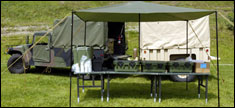Assault Kitchen to speed field feeding
By Curt Biberdorf
 Kitchen saves times, hassle of serving hot meals on frontlines.
Kitchen saves times, hassle of serving hot meals on frontlines.
Sarah Underhill
|
|
|
NATICK, Mass. (Army News Service, Sept. 8, 2004) -- The ability to quickly feed hot meals to forward-deployed, fast-moving warfighters is what the Army will gain when the Assault Kitchen delivers its heat-on-the-move capability to the field.
Intended to replace the “Kitchen, Company Level Field Feeding” beginning in 2007, the Assault Kitchen will provide a better way to feed company-sized military units, according to officials.
The Assault Kitchen was developed by the Food Service Equipment Team under Product Manager Force Sustainment Systems at the U.S. Army Soldier Systems Center in Natick, Mass.
"The KCLFF is an assortment of odds and ends. Many times, frontline units don't take it to the field other than a component here and there," said Doug Brown, a mechanical engineer and project officer for the Assault Kitchen. "They tend to not want to operate with the whole system because of the setup involved. It takes more time and effort to use when compared to the AK."
The Assault Kitchen consists of a Humvee and trailer packed with equipment that either eliminates, transfers or replaces the collection of loose KCLFF items with a setup where every component has its place on a mobile platform.
A Humvee carries six insulated beverage containers, three pan carriers to keep food trays warm, five insulated food containers, a 5-gallon fuel can, fire extinguisher, utensil box, maintenance kit for the ration heater, and a ration heater to prepare Unitized Group Ration-Heat and Serve tray packs or No. 10 food-service cans strapped into the cargo area.
A trailer carries eight water cans, an ice chest, three tables, cargo netting to hold tray pack boxes, stock pots, a cradle for use in preparing hot beverages and an awning to cover the serving area during bad weather.
The heart of the AK is its ration heater, officials said. It uses non-developmental and commercial technology that allows operation on common battlefield fuels, and it draws electricity generated from the Humvee through a mounted power inverter.
"We used already-developed ration heaters and as many existing pieces of commercial equipment as possible," said Scott Mannka, an engineering technician, about the 1-year-old project that produced two prototypes. "It's the only way we could build AK prototypes fast."
The AK heater tank is turned on with a switch and operates for 10 hours on 5 gallons of fuel. The portable, stainless steel water tank heats up to 18 tray packs, 15 No. 10 food-service cans or a combination of the two in 30-45 minutes, and it can heat them while driving, which is not an option with the KCLFF's open flame burners, according to Brown.
Thermostatic control assures the heater tank's water temperature stays below the boiling point, but a relief vent is a backup to prevent overpressure. Other safety features include sensors or switches to shut off the burner if the water depth in the tank falls below 6 inches or the heater tank exceeds specified angles.
The Assault Kitchen feeds up to 250 troops in one location or as many as 500 troops daily in multiple locations, and setup is completed in as little as 10 minutes with two cooks, according to Brown. Packing up to be ready to "jump" to the next feeding site is equally as fast.
Two approaches to using the Assault Kitchen were followed during a user demonstration earlier this year. Brown said both prototypes were praised by troops who tried them.
In January at Fort Stewart, Ga., troops tried a "pit stop" feeding method, hauling the kitchen to the Soldiers with a fuel and ammunition supply convoy. Tankers and infantrymen either met the kitchen and convoy at a designated location or the supply convoy went to them.
At the National Training Center at Fort Irwin, Calif., in March and April, the kitchen stayed with forward units at all times and was re-supplied with rations and water whenever possible.
"The vision at first was not to stay with a forward unit at NTC," Mannka said. "They liked it a lot. They were impressed. They gained confidence with it every day they used it."
The team plans on refining the system and completing additional testing during the next two years, combining the best features of the two prototypes into one prototype before production approval in 2006. Brown said current plans for production are for the Army, Marine Corps, and potentially the Air Force, to combine their requirements for the Tray Ration Heater and the Assault Kitchen into a large economical production contract.
For more information about the U.S. Army Soldier Systems Center, visit www.natick.army.mil.
(Editor’s note: Curt Biberdorf is the editor of the Warrior magazine.)
Additional Photos:

|


